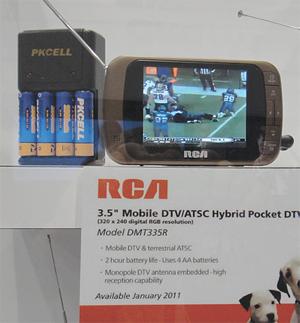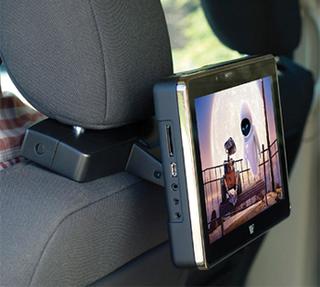Exploring Mobile DTV At CES 2011

One lesson I've learned after attending several International Consumer Electronics Shows in Las Vegas is that if you don't see what you're looking for this year, wait until next year. If it isn't on display then, it probably isn't relevant.
I observed this with portable legacy ATSC receivers and again with ATSC Mobile DTV receivers. This year at CES several manufacturers were showing a range of ATSC Mobile DTV products—some in private suites, but many exhibited on the floor.
PORTABLE TELEVISIONS
The RCA introduction of a line of portable TVs and an in-car receiver with mobile DTV capability shows ATSC Mobile DTV is becoming mainstream. RCA's products include two 3.5-inch hybrid pocket DTV sets, one with FM radio (DMT336R) and one without the radio (DMT335R) and a 7-inch portable (DMT270R). The in-car receiver (DMT3BR), with its monopole antenna and channel switch on top, looks like it is designed to sit on the dashboard. All of these devices had a sign saying "Available January 2011."
LG showed a variety of handheld ATSC mobile DTV receivers, including one with an autostereoscopic 3D display (no glasses required). It was picking up an off-air ATSC MH signal and while I'm not a fan of 3D, it didn't look bad. LG was showing Mobile DTV along with a non-real-time (NRT) coupon application on a prototype full-touch CDMA smartphone.

Tivizen from South Korean company Valups, receives Mobile DTV signals for the iPad and iPhone and will go on sale in June for $99.

Hauppauge's WinTV-Aero-m is designed to watch live, over-the-air, digital TV on a PC-based laptop or netbook. It will have an MS RP of $69.
Winegard displayed its innovative CIO media player with ATSC mobile DTV capability, but the prototype unit I saw displayed clearly needed some tweaking.
DONGLES FOR EXISTING DEVICES
Not everyone will want to carry around a separate screen for Mobile DTV. I saw a number of Mobile DTV Wi-Fi access points, including the Cydle and Valups Tivizen devices shown last year.
Interest in these devices was eclipsed by the Valups Tivizen dongle for the iPad, iPhone and iTouch. As you can see from the photo, this small device plugs directly into the standard Apple 30-pin connector. The antenna is a small wire loop that should be less vulnerable to damage than a rigid telescoping antenna. Conceivably, it could be made larger or a second loop added to improve high-band VHF reception.
Hauppauge showed its new Aero-M ATSC USB tuner. The Aero-M includes both conventional ATSC and Mobile DTV capability. It comes with a short telescoping monopole antenna built into the tuner housing and an external dipole antenna, which can be plugged into a very small coax connector on the side of the tuner. An F-type adapter cable is available for use with a larger antenna.
The ultimate convenience is having the ATSC Mobile DTV tuner built into the device. Hauppauge showed its mini PCI Express tuner card installed in a Dell netbook. The netbook can use an internal antenna, but also has a coax jack (same size as the one on the Aero-M) to connect to an external antenna.
At the Mobile Content Venture booth the Samsung Galaxy Tab with a built-in ATSC Mobile DTV tuner always seemed to have people around it. The screen and reception were beautiful.
While I didn't notice any Dell tablets on the CES floor (Dell had its own private display area at the Palms), Dell is committed to Mobile DTV, according to John Thorpe, Dell's vice president for mobile. "Dell is committed to delivering the ultimate entertainment experience for its customers and has been an early mover in Mobile DTV," Thorpe said. Don't be surprised if you see some Mobile DTV-capable Dell tablets on the market later this year.
CHIPS AND BOARDS
All of this Mobile DTV goodness is made possible by the chipsets and circuit boards manufacturers use in their products. Manufacturers I talked to liked the Siano SoC ("System on Chip") developed in cooperation with LG Electronics for its low-power consumption. The LG2161 or older LG2160 demodulator chip and a MaxLinear tuner was a popular configuration for less power-sensitive devices.
Enspert and Samsung have ATSC-MH chipsets but I didn't see either on the floor at CES. Crest Technology displayed ATSC-MH circuit boards for everything from dongles to Mobile DTV Wi-Fi access points to in-car receivers.

Digital Stream, licensee of the RCA brand, debuted four hybrid handheld Mobile DTV/Off-Air receivers. The line of portable sets will be available in 3.5-inch and 7-inch versions and will cost between $109 and $169.

Antenna maker Winegard debuted cioTV, the industry's largest display for cars for receiving Mobile DTV.
Manufacturers displaying products at CES told me they need more Mobile DTV channels on the air. If that doesn't happen, there may not be many ATSC Mobile DTV products at CES 2012, and certainly little new development.
The good news is that groups like the Mobile Content Venture (MCV) and the Mobile 500 Alliance are organizing stations to begin broadcasting mobile DTV. MCV has promised to have at least two mobile channels on the air in 20 markets this year. They are not too far from that goal today.
DTV Interactive had more good news at CES—they showed an ATSC Mobile DTV multiplexer and TV broadcast exciter that will sell for a package price of around $50,000. They are working with another company to offer a low-cost software-based H.264/AAC encoder suitable for Mobile DTV.
Manufacturers are interested in Mobile DTV. Now it's up to broadcasters to continue their efforts to put mobile DTV streams on the air throughout the country. Stations are adding Mobile DTV streams at a rapid rate and, as a result, many of the lists of mobile DTV streams on the air are out of date as soon as they are published.
Comments are welcome! E-mail me at dlung@transmitter.com.
Get the TV Tech Newsletter
The professional video industry's #1 source for news, trends and product and tech information. Sign up below.
Doug Lung is one of America's foremost authorities on broadcast RF technology. As vice president of Broadcast Technology for NBCUniversal Local, H. Douglas Lung leads NBC and Telemundo-owned stations’ RF and transmission affairs, including microwave, radars, satellite uplinks, and FCC technical filings. Beginning his career in 1976 at KSCI in Los Angeles, Lung has nearly 50 years of experience in broadcast television engineering. Beginning in 1985, he led the engineering department for what was to become the Telemundo network and station group, assisting in the design, construction and installation of the company’s broadcast and cable facilities. Other projects include work on the launch of Hawaii’s first UHF TV station, the rollout and testing of the ATSC mobile-handheld standard, and software development related to the incentive auction TV spectrum repack. A longtime columnist for TV Technology, Doug is also a regular contributor to IEEE Broadcast Technology. He is the recipient of the 2023 NAB Television Engineering Award. He also received a Tech Leadership Award from TV Tech publisher Future plc in 2021 and is a member of the IEEE Broadcast Technology Society and the Society of Broadcast Engineers.

